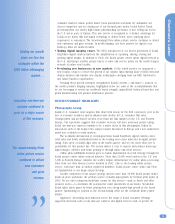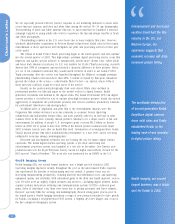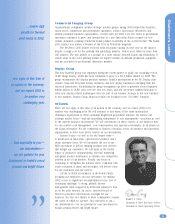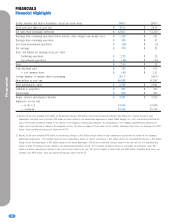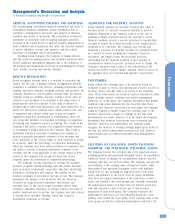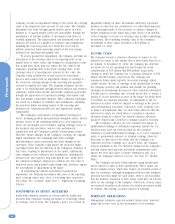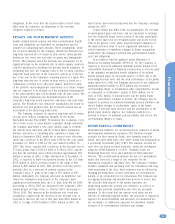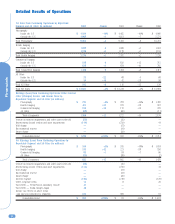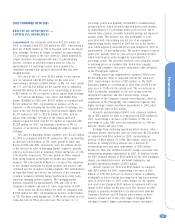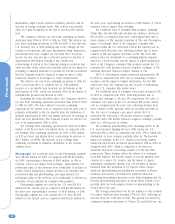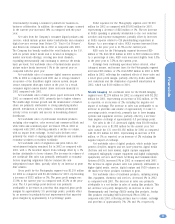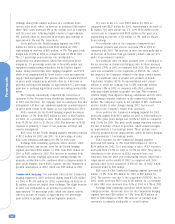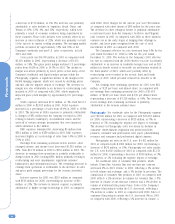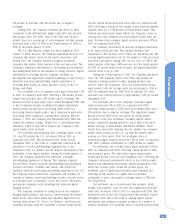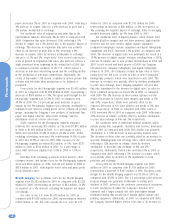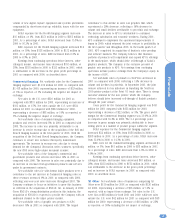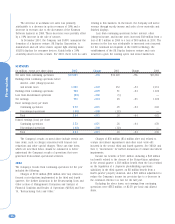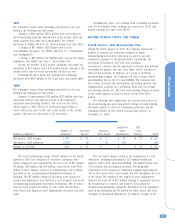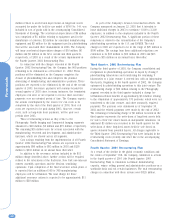Kodak 2002 Annual Report Download - page 13
Download and view the complete annual report
Please find page 13 of the 2002 Kodak annual report below. You can navigate through the pages in the report by either clicking on the pages listed below, or by using the keyword search tool below to find specific information within the annual report.
Financials
13
retail industry’s leading e-commerce platform for business-to-
business collaboration. In addition, the number of images scanned
in the current year increased 19% as compared with the prior
year.
Net sales from the Company’s consumer digital products and
services, which include picture maker kiosks/media and consumer
digital services revenue from Picture CD, “You’ve Got Pictures”,
and Retail.com, remained flat in 2002 as compared with 2001.
The Company has broadly enabled the retail industry in the U.S.
with its picture maker kiosks and is focused on bringing to
market new kiosk offerings, creating new kiosk channels,
expanding internationally and continuing to increase the media
burn per kiosk. Net worldwide sales of thermal media used in
picture maker kiosks increased 11% in the current year as
compared with the prior year.
Net worldwide sales of consumer digital cameras increased
10% in 2002 as compared with 2001 due to strong consumer
acceptance of the EasyShare digital camera system, despite
sensor component shortages earlier in the year. As a result,
consumer digital camera market share increased modestly in
2002 compared with 2001.
Net worldwide sales of inkjet photo paper increased 43% in
2002 as compared with 2001, primarily due to higher volumes.
The double-digit revenue growth and the maintenance of market
share are primarily attributable to strong underlying market
growth, introduction of new products, continued promotional
activity at key accounts and success in broadening channel
distribution.
Net worldwide sales of professional sensitized products,
including color negative, color reversal and commercial black and
white films and sensitized paper, decreased 13% in 2002 as
compared with 2001, reflecting primarily a decline in volume,
with no impact from exchange. Overall sales declines were
primarily the result of ongoing digital substitution and continued
economic weakness in markets worldwide.
Net worldwide sales of origination and print film to the
entertainment industry remained flat in 2002 as compared with
2001, with a 1% favorable impact from exchange offset by a 1%
decline attributable to lower volumes. The decrease in volumes of
net worldwide film sales was primarily attributable to economic
factors impacting origination film for commercials and
independent feature films, partially offset by an increase in print
film volumes.
Gross profit for the Photography segment was $3,219 million
for 2002 as compared with $3,402 million for 2001, representing
a decrease of $183 million or 5%. The gross profit margin was
35.8% in the current year as compared with 36.2% in the prior
year. The 0.4 percentage point decrease was primarily
attributable to decreases in price/mix that impacted gross profit
margins by approximately 3.0 percentage points, partially offset
by an increase in productivity/cost improvements that impacted
gross margins by approximately 2.6 percentage points.
SG&A expenses for the Photography segment were $1,935
million for 2002 as compared with $1,963 million for 2001,
representing a decrease of $28 million or 1%. The net decrease
in SG&A spending is primarily attributable to the cost reduction
activities and expense management, partially offset by increases
in SG&A expense related to CIS photofinishing acquisitions in
Europe. As a percentage of sales, SG&A expense increased from
20.9% in the prior year to 21.5% in the current year.
R&D costs for the Photography segment decreased $29
million or 5% from $542 million in 2001 to $513 million in 2002.
As a percentage of sales, R&D costs decreased slightly from 5.8%
in the prior year to 5.7% in the current year.
Earnings from continuing operations before interest, other
(charges) income, and income taxes for the Photography segment
decreased $16 million, or 2%, from $787 million in 2001 to $771
million in 2002, reflecting the combined effects of lower sales and
a lower gross profit margin, partially offset by SG&A and R&D
cost reductions and the elimination of goodwill amortization in
2002, which was $110 million in 2001.
Health Imaging Net worldwide sales for the Health Imaging
segment were $2,274 million for 2002 as compared with $2,262
million for 2001, representing an increase of $12 million, or 1%
as reported, or an increase of 2% excluding the negative net
impact of exchange. The increase in sales was attributable to an
increase in price/mix and volume of approximately 0.4 and 1.1
percentage points, respectively, primarily due to laser imaging
systems and equipment services, partially offset by a decrease
from negative exchange of approximately 0.8 percentage point.
Net sales in the U.S. decreased slightly from $1,089 million
for the prior year to $1,088 million for the current year. Net
sales outside the U.S. were $1,186 million for 2002 as compared
with $1,173 million for 2001, representing an increase of $13
million, or 1% as reported, or an increase of 2% excluding the
negative impact of exchange.
Net worldwide sales of digital products, which include laser
printers (DryView imagers and wet laser printers), digital media
(DryView and wet laser media), digital capture equipment
(computed radiography capture equipment and digital radiography
equipment), services and Picture Archiving and Communications
Systems (PACS), increased 5% in 2002 as compared with 2001.
The increase in digital product sales was primarily attributable to
higher digital media, service, digital capture and PACS volumes as
the market for these products continues to grow.
Net worldwide sales of traditional products, including analog
film, equipment, chemistry and services, decreased 4% in 2002
as compared with 2001. The decrease in sales was primarily
attributable to a net decline in sales of analog film products. This
net decrease was partly mitigated by an increase in sales of
Mammography and Oncology (M&O) analog film products. Analog
film products (excluding M&O) decreased 8% in 2002 as
compared with 2001, reflecting declines due to volume, exchange
and price/mix of approximately 5%, 2% and 1%, respectively.


